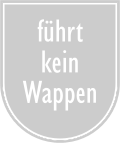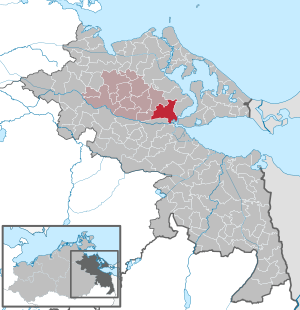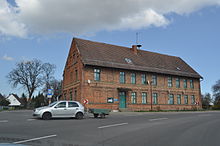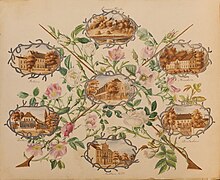Murchin
| coat of arms | Germany map | |
|---|---|---|

|
Coordinates: 53 ° 54 ' N , 13 ° 45' E |
|
| Basic data | ||
| State : | Mecklenburg-Western Pomerania | |
| County : | Vorpommern-Greifswald | |
| Office : | Züssow | |
| Height : | 14 m above sea level NHN | |
| Area : | 46.27 km 2 | |
| Residents: | 766 (Dec. 31, 2019) | |
| Population density : | 17 inhabitants per km 2 | |
| Postal code : | 17390 | |
| Primaries : | 03971, 038374 | |
| License plate : | VG, ANK, GW, PW, SBG, UEM, WLG | |
| Community key : | 13 0 75 094 | |
| Community structure: | 5 districts | |
| Office administration address: | Dorfstrasse 6 17495 Züssow |
|
| Website : | ||
| Mayor : | Peter Dinse | |
| Location of the municipality of Murchin in the Vorpommern-Greifswald district | ||
Murchin is a municipality in the middle of the Vorpommern-Greifswald district. It has been administered by the Züssow Office , based in Züssow , since January 1, 2005 . The municipality is one of the largest in terms of area in the office and belonged to the Ziethen office until December 31, 2004 . It has 949 inhabitants (as of December 31, 2015).
geography
Geographical location
The municipality of Murchin is located about seven kilometers northeast of Anklam and about ten kilometers west of the island of Usedom . The federal road 110 runs through the municipality . The Peene flows into the Peene River at the southeastern municipal boundary . The south of the community is forested. The forest areas Libnower Wald , Pinnower Forst and Murchiner Wald are located here . The land becomes very swampy in the direction of Peene, here is the nature reserve Unteres Peene Valley (Peenetalmoor) . There are several lakes in the municipality, including the Pinnower See and the Küchensee .
Community structure
|
|
|
Neighboring communities
Neighboring communities are Rubkow in the north, Lassan (city) in the northeast, Buggenhagen in the east, Usedom (city) in the southeast, Bargischow and Anklam (city) in the south, Ziethen in the west and Klein Bünzow in the northwest.
history
Lentschow
Lentschow was first mentioned in documents as Lentzkow in 1491 . In 1491 the Steding family (they were already mentioned in a Stralsund document in 1256) received the estate. This transfer of ownership in Lentschow was mentioned in a document in the Wolgast church registers. However, this contradicts a document from March 23, 1447, kept in the Stralsund City Archives, issued by Duke Wartislaw IX. from Pomerania, in which a "Vycke Stedynk the boy" to lenczekow "(Lentschow)" is mentioned among the witnesses. The estate remained in the family's possession until 1803, when it passed to the von Schulz family, who sat on Pinnow. Von Schulz sold in 1819 to Plath, who in turn sold it to Erdmann Loesewitz in 1829, whom his son Friedrich Loesewitz followed as owner from 1844 to 1908.
Lentschow had 111 inhabitants in 19 families in 1865. There were 7 residential and 13 farm buildings in the village. In 1925 Lentschow had 129 inhabitants. In the course of the formation of large communities in the Greifswald-Land district , Buggenhagen , Murchin, Pulow , Wehrland and Zemitz were incorporated into Lentschow on October 15, 1938. In 1939 Lentschow had 1,969 inhabitants.
The von Loesewitz family (also Lösewitz) owned the estate until 1945.
With the dissolution of the large communities on August 1, 1946, the places incorporated in 1938 and the district of Pinnow bei Anklam became independent communities for the first time. On July 1, 1950, Lentschow was incorporated into the community of Murchin.
On December 31, 2014, Lentschow had 70 residents with a main residence and 9 with a secondary residence.
On December 31, 2015, Lentschow had 73 residents with a main residence and 9 with a secondary residence.
Libnow
Libnow was first mentioned Ribenitz in a document , first in 1168. The name comes from the stream of the same name and is derived from Fisch (Slavic - Ryba ). In 1782 the name changes to Libnow .
The Libnow estate was owned by Murchin. From 1792 to 1819 Count Friedrich Ludwig von Bohlen was the owner of Libnow and Murchin on Karlsburg. In 1819 Wilhelm von Homeyer († 1842), who had acquired the Murchin and Libnow estates, became the landlord. In 1849 the two estates were separated from each other and given to Homeyers' two sons. The elder Friedrich received Murchin and the younger Wilhelm (1828–1903) received Libnow. The manor house in Libnow was built by him in 1862. The brick building with a field stone base was built in the Tudor style.
In 1865 Libnow had 109 inhabitants in 21 families. 8 residential and 12 farm buildings as well as 1 factory were available in the place.
Ownership of the estate changed often, until 1945 Otto Hoehne was the last owner of the 600 hectare estate.
During the GDR era, the VEB Edelweiß Magdeburg textile cleaning company built and maintained a company holiday camp for the children in the manor house, which fell into disrepair after 1990. Privatized since 2000, it serves the Quies / Lorenz family of artists as a residence, studio and exhibition space.
On December 31, 2014, Libnow had 81 residents with a main residence and 4 with a secondary residence.
On December 31, 2015, Libnow had 82 residents with a main residence and 3 with a secondary residence.
Murchin
Murchin was first mentioned in a document as Morchin in 1257 . A name interpretation is not available. The current name was first used in 1631.
Murchin was a typical manor village with a dominant estate and a few farm workers' cottages, a small church and a jug at the intersection. The Vierpottkaten (monument) existing in the village is a thatched type building for the accommodation of day laborers at the time. It means that around the one common central kitchen (open central chimney = black kitchen), four day laborer's apartments with additional stalls in the attic are grouped.
The Murchin fiefdom was for a long time a rolling estate; that is, it had constantly changing owners. Around 1750 it was bought by the Schwerin family through the famous field marshal Kurt Christoph Graf von Schwerin from the Schwerinsburg family. He died in 1757 and bequeathed the estate to his nephew from the von Parsenow family . But even this ownership lasted relatively short, it was followed by the owner Graf von Bohlen auf Karlsburg until 1819. Johann Friedrich von Homeyer from Wolgast bought the connected goods Libnow and Murchin, after his death in 1842 the property was divided in 1849, the younger son Friedrich received Murchin and the elder Wilhelm received Libnow.
In 1865 Murchin had 241 residents in 39 families. The place had 1 church, 1 school, 13 residential and 21 farm buildings, and 1 factory.
Friedrich von Homeyer's subsequent heir was Hans von Magdeburg-Homeyer, whose family remained the owner until 1945.
After the war, Murchin grew considerably through the construction of the new farmers' settlements.
In the GDR's first five-year plan , it was decided to set up cultural centers in rural areas. The MAS Matyas Rakosi had in 1950 and 1951 can decide for socialist competition of machinery lending stations and received the biggest cultural center of the GDR in rural areas in the fifties. So the government has been commissioned to design by the architects Graening and Goltzow 1952-1954 District Culture House Murchin built. The main facade of the T-shaped structure, like the Heringsdorfer Kulturhaus, is characterized by a gabled pillar portico. Walter Bullert created four reliefs on the left wing of the building. They report on the work in socialist agriculture and show the preparation of the sowing, the harvest, the processing of agricultural products by industry and the training of the farmers. Each of the reliefs emphasizes the representation of the modernity with which production is carried out for the new society. The inauguration took place on May 1, 1954. Manfred Kandt, Otto Manigk and Herbert Wegehaupt had painted the restaurant of the Kulturhaus in the Hungarian colors in 1954 with figurative scenes depicting the friendly relationship between the Hungarians and GDR Germans who have become “brother peoples”. It became the district culture center for the then Anklam district.
After 1990 it became a popular disco called HyperDome , which had to close in 2002.
As of December 31, 2014, Murchin had 298 residents with a main residence and 23 with a secondary residence.
On December 31, 2015, Murchin had 298 residents with a main residence and 22 with a secondary residence.
Pinnow
Pinnow was first mentioned in a document as Pinnowe in 1261 . The Slavic name means tree stump .
Pinnow bei Anklam, as it is called to distinguish places with the same name, was a manor, church and parish. The Pinnow village church was built around 1400 .
The von Lepel family was officially named as the owner in 1388 as heir and feudal residents of Pinnow. They are the brothers Ludeke, Martin and Henning, from 1410 Heinrich and Gherd (1409 also mayor of Lassan); it followed in 1431 Jochen von Lepel. The Stenwer ( Steinwehr ) family had been the owners since 1491 and the Grambow family around 1550, then Gideon von Klemptzen (professor at the University of Greifswald). In 1583, Duke Ernst Ludwig gave the brothers Victor and Joachim Steding a letter of approval on Pinnow. Christoph Adam von Steding handed Pinnow over to his son-in-law Franz Heinrich von Reichenbach as a wedding property in 1756. From 1806 Pinnow formed a manor district in the office or then the district of Greifswald.
It is unclear when the von Reichenbach family moved to a wife von Schulz, but in 1819 Hans Ludwig Heinrich von Behr bought the estate from Schmoldow and Vargatz with the owners Johannishof and Immenstedt. In 1856 Carl August Julius von Behr (1832–1882) was a landlord. He was followed by Carl von Behr (1864–1941) who inherited the estate in 1882. He was District Administrator in Plön and Cabinet Councilor of Empress Auguste Viktoria, came to Pinnow in 1911. He developed controversial theories on heredity and nobility renewal.
In 1865, Pinnow had 161 inhabitants in 30 families. There was 1 church, 1 school, 12 residential and 8 farm buildings, as well as 2 factories in the village.
The village was a hybrid of anger and street village. The area with the historical buildings (manor, church, churchyard and parish farmstead) was present until 1920, only a small row of farm workers was present in the direction of the Murchin road - Zecheriner bridge. After 1920 the main village was built on this street, which today makes up the actual village with its restaurants, shops, businesses and houses. In 1929 the manor district was dissolved and incorporated into the community of Murchin. Pinnow bei Anklam was umgemeindet from October 15, 1938 as a district to Lentschow. The Pinnow estate remained in the possession of the von Behr family until 1945.
After taking in displaced persons and refugees mainly from eastern parts of Pomerania and other parts of eastern Prussia, Pinnow near Anklam was spun off from Lentschow on August 1, 1946 and became an independent municipality. As a result of the migration of many new residents, Pinnow near Anklam was incorporated into Murchin on July 1, 1961. Later a leisure settlement (bungalows) was built on the Pinnower See.
On December 31, 2014, Pinnow had 181 residents with a main residence and 19 with a secondary residence.
On December 31, 2015, Pinnow had 230 residents with a main residence and 20 with a secondary residence.
Relzow
Relzow was mentioned in a document in 1257 as Reletsowe in Bishop Hermann's letter of tithe to the church in Ziethen. The Slavic place name is not interpreted. The Slavic foundation is evidenced by a larger archaeologically proven settlement from the late Slavic period (1000 to 1200) on the area of today's village.
In 1495 it was given to the Wulff family as dominal by Duke Bogislaw X. The three estates Relzow, Ramitzow and Daugzin belonged together and were fiefdoms ever since. The Wulff had their residence in Relzow. Around 1606 the goods were divided up because of pledges.
Relzow had changing owners and pledges of individual farms until around 1800. In 1801 the estate was owned by Friedrich Wilhelm von Barthold, who in the same year sold it to Bleichert von Wolffradt and who in turn sold it in 1802 to his son-in-law, Captain August Wilhelm von Bornstädt. Wilhelm von Bornstädt was in the possession of Relzow from 1843 to 1865.
Relzow was a typical manor village with manor and farm workers' cottages. The unrenovated manor house dates from the first half of the 18th century; most of the other farm buildings on the property have been removed and built over. The small estate park is only recognizable as a relic.
Relzow had 161 inhabitants in 30 families in 1865. The following buildings were available: 1 school, 10 residential and 16 farm buildings.
It has extensive forests in its field marrow and many peat cuttings towards the Peene Valley.
Since 1897 Relzow was affected by the Anklam-Lassaner Kleinbahn (ALKB) and had a stop. Like all Pomeranian small railways, the ALKB was dismantled and transported away as a repair after temporary reductions in 1945.
During the GDR era there was a larger NVA site near Relzow, which was given up in 1991 by the Bundeswehr.
Relzow had 196 residents with main residence and 14 with secondary residence on December 31, 2014.
Relzow had 199 residents with main residence and 13 with secondary residence on December 31, 2015.
Housing areas and desertification
Immenstädt (residential space)
The name Immenstädt means apiary . Immenstädt (also Immenstadt and Immenstedt ) was a pertinence ( Holländerei ) to Pinnow and was already abandoned around 1865 without buildings. In 1891 it was re-established as a Vorwerk zu Pinnow and is now built on and inhabited.
Johannishof (living space)
Johanneshof was first mentioned in a document in 1782. Johannishof is located south of Pinnow and, according to the Prussian Urmeßtischblatt from 1835, was a Vorwerk to Pinnow and belonged to the owner there. This leased, in 1865 z. B. a gentzke of the tenants of the court. Around 1880 the place was a forest farm. During the GDR era there was an agricultural enterprise (LPG) there, since 1990 it has only been a residential area.
In 1867 the barge and Pram ferries Klotzower Fähre and Pinnower Fähre could no longer handle the traffic to the island of Usedom. A road embankment (today's B 110) was raised from Johannishof south of Pinnow to the Peenestrom, and a fiscal ferry station with a ferry station was set up at the so-called Schwemmort. When the spa business on the island of Usedom experienced a rapid boom in the 1920s, the capacities of the ferry connections between Schwemmort on the mainland and the island soon reached their limits. Therefore, the district of Usedom-Wollin initiated the construction of a road bridge. Construction work began in 1930. On May 22, 1931, the connection was opened as the Usedom bathing bridge.
Johannesberg (living space)
Johannisberg belongs to Johannishof according to TK 1998 and consists only of a small homestead and is now a residential area. It was built around 1880 as a courtyard for the local windmill.
Lubkow (desert)
Lubkow was first mentioned in 1782. It was not far from Pinnow and cannot be precisely located. A few years later it fell desolate again.
Mechomyrzk (desert)
Mechomyrzk was first mentioned in 1194 and in 1304 in the provincia Cyten (Ziethen). Historians assume that it was the forerunner of the village of Murchin, which was lost due to the development.
Fährhof-Pinnower ferry (desert)
Pinnower Ferry was first mentioned in 1792. Until the establishment of the fiscal Schwemmort - Zecheriner Fähranstalt in 1867, this and the Klotzow ferry were the connection to the island of Usedom. In 1932 and until 1998 the place was named Fährhof.
In 2003 the district was inhabited and was stated as a ruin, after the Peeneweide polder was flooded, there is a water surface here.
Floodplain (desert)
The ferry station was established in 1867 as a replacement for the Klotzower and Pinnower ferry. With the built dam from Johannishof to the Peenestrom, the connection to the island of Usedom near Zecherin was created. The Zecheriner bridge starts there today as a mainland point.
politics
Coat of arms, flag, official seal
The municipality has no officially approved national emblem, neither a coat of arms nor a flag . The official seal is the small state seal with the coat of arms of the region of Western Pomerania . It shows an erect griffin with a raised tail and the inscription "GEMEINDE MURCHIN".
Culture and sights
Buildings
- Brick church from 1604 in Murchin
- Manor and Gut Murchin
- The district community center was built in the years 1952 to 1954 after plans by Graening and Goltzow after the machine and tractor station in 1950 and 1951, the traveling banner of Ministers of the GDR brought to the region. The building in the style of socialist classicism was used as a district culture house from 1964. On the left front is a relief by Walter Bullert with the title The work of agriculture in the four seasons .
- Vierpottkaten Murchin
- Libnow mansion , brick building in Tudor style built in 1862. Remnants of the estate and park exist.
- Libnow tower hill
- Manor house in Relzow. This already existed in the 15th century, a family Schinkel owned. It was later bought by the von Bornstaedt family. The last owner bequeathed it to her nephew, who is still alive today (as of 2011).
- NVA barracks Relzow with solar park
- Pinnow village church
Green spaces and recreation
Economy and Infrastructure
Public facilities
In Murchin, a little south of the village, there is a youth hostel on the Triensee .
Since there is no school in Murchin itself, it is necessary for pupils of the community to go to Anklam (several secondary schools and the Lilienthalgymnasium ), to Usedom (city) or to Lassan to the local secondary school.
traffic
A small railway connection from 1896 of the Anklam-Lassaner small railway , through which Murchin was connected with Anklam, Lassan and Buddenhagen , was already substantially reduced in the 1920s and was dismantled in 1945 after the end of the Second World War as a reparation payment to the Soviet Union.
In regional traffic, Murchin is connected by the regional bus line 201 Anklam - Murchin - Heringsdorf of Ostseebus GmbH with 7 trips on weekdays and 4–5 trips on weekends. The route Ankam - Murchin - Lassan is offered with up to five daily connections, the travel times of which are strongly geared towards school traffic.
Personalities
Sons and daughters of the church
- Curt von Stedingk , also Bogislaw von Stedingk (born October 26, 1746 in Lentschow, † January 7, 1837 in Stockholm), Swedish field marshal and diplomat
- Victor von Stedingk (born November 11, 1751 in Lentschow, † November 30, 1823 in Stockholm), Swedish admiral of the archipelago fleet
- Friedrich von Behr (born November 3, 1821 on Gut Pinnow; † January 13, 1892), landowner, politician, member of the Prussian manor house
- Julie von Massow , b. von Behr (born November 24, 1825 in Pinnow, † March 5, 1902 in Dresden, buried in Rohr / Trzcinno, Rummelsburg / Miastko district), founder of the Psalms Association, writer, founder of the prayer association "Ut Omnes Unum"
- Carl von Behr (born June 27, 1864 in Pinnow, † May 4, 1941 in Berlin), District Administrator in Plön and Cabinet Councilor of Empress Auguste Viktoria,
- Martin Eichler (born March 29, 1912 in Pinnow; † October 7, 1992 in Arlesheim near Basel, Switzerland), German mathematician who dealt with algebraic geometry and number theory
- Gunter Jess (* 1951), politician (AfD)
literature
- Manfred Niemeyer: East Western Pomerania. Collection of sources and literature on place names. Vol. 2: Mainland. (= Greifswald contributions to toponymy. Vol. 2), Ernst-Moritz-Arndt University of Greifswald, Institute for Slavic Studies, Greifswald 2001, ISBN 3-86006-149-6 . Pages 81, 82, 92, 103, 113
- Heinrich Berghaus : Land book of the Duchy of Pomerania and the Principality of Rügen. IV. Part Volume II, Anklam 1868 Google Books p. 1052 for parish Murchin, pp. 1054-1061 for parish Pinnow, p. 1144 for parish Ziethen
- Eckhard Oberdörfer: Ostvorpommern, Edition Temmen, Bremen, 2006, ISBN 3-86108-917-3
- Marcelle and Fritz von Behr: Documents and research on the history of the Behr family, Gützkower Line (Die Schwanenhälsigen), Volume VII, Part I and II, Bremen 1989.
- Sister Maria Bernardina Grua: Julie von Massow, née von Behr. A picture of converts from the 19th century, Herdersche Verlagbuchhandlung; Freiburg 1902.
Individual evidence
- ↑ Statistisches Amt MV - population status of the districts, offices and municipalities 2019 (XLS file) (official population figures in the update of the 2011 census) ( help ).
- ↑ a b c d e f Amt Züssow, residents of the Züssow district, as of December 31, 2015
- ↑ a b c d e f g h i j Manfred Niemeyer: Ostvorpommern . Collection of sources and literature on place names. Vol. 2: Mainland. (= Greifswald contributions to toponymy. Vol. 2), Ernst-Moritz-Arndt University of Greifswald, Institute for Slavic Studies, Greifswald 2001, ISBN 3-86006-149-6 . P. 54 ff
- ↑ Stadtarchiv Stralsund, Rep. 9 U (Heilgeistkloster Stralsund, documents), no. 233. Since the other witnesses were all nobles from the area, u. a. Salchow, Ziethen, Pinnow, there should be no doubt about the assignment.
- ^ A b c Michael Rademacher, "Stadt und Landkreis Greifswald" , on: German administrative history from the unification of the empire in 1871 to the reunification in 1990 , accessed on June 24, 2020 (online material for the dissertation, Osnabrück 2006).
- ↑ Gothaisches genealogical pocket book of the letter aristocratic houses. Volume 7, Perthes, 1913, page 510.
- ↑ a b c d e Züssow Office, residents of the Züssow administrative area, as of December 31, 2014
- ^ Hubertus Neuschäffer: Western Pomerania's castles and mansions . Husum Druck- und Verlagsgesellschaft 1993, p. 116, ISBN 3-88042-636-8
- ^ Hubertus Neuschäffer: Western Pomerania's castles and mansions . Husum Druck- und Verlagsgesellschaft 1993, p. 134, ISBN 3-88042-636-8
- ↑ Dirk Handorf: Hoards of order and size. 1996, p. 41.
- ^ Ulrich Hartung: Workers 'and farmers' temples. GDR culture houses of the fifties - an architectural compendium. Berlin 1996, p. 178.
- ↑ Dirk Handorf: Hoards of order and size. 1996, p. 41.
- ↑ Murchin: From the Hyperdome in front of Usedom (accessed on August 7, 2013)
- ↑ Hain, Schroedter, Stroux: The salons of the socialists. Culture houses in the GDR. 1996, p. 125.
- ↑ Main Statute, Section 1, Paragraph 2 (PDF).
- ↑ Klaus Kieper, Reiner Preuß and Elfriede Rehbein: Narrow-gauge railway archive. Pp. 99-105. transpress VEB publishing house for transport, Berlin 1980.
- ↑ Timetable regional bus Anklam-Murchin-Lassan ( Memento of the original from July 1, 2013 in the Internet Archive ) Info: The archive link was inserted automatically and has not yet been checked. Please check the original and archive link according to the instructions and then remove this notice. (accessed on August 9, 2013)











